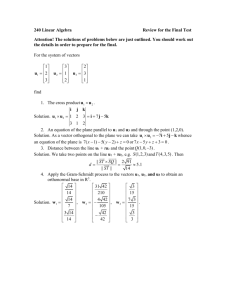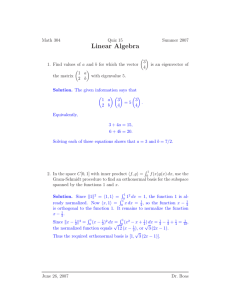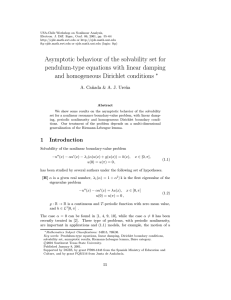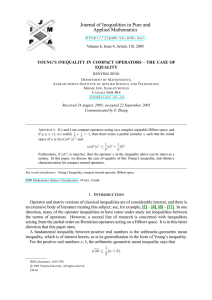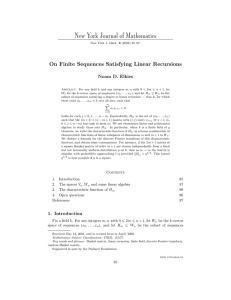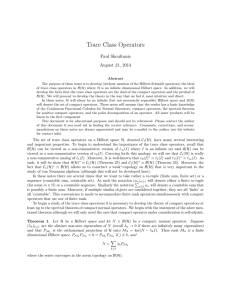Selected solutions of assignment problems MATH 608 4.15. Write ˜
advertisement
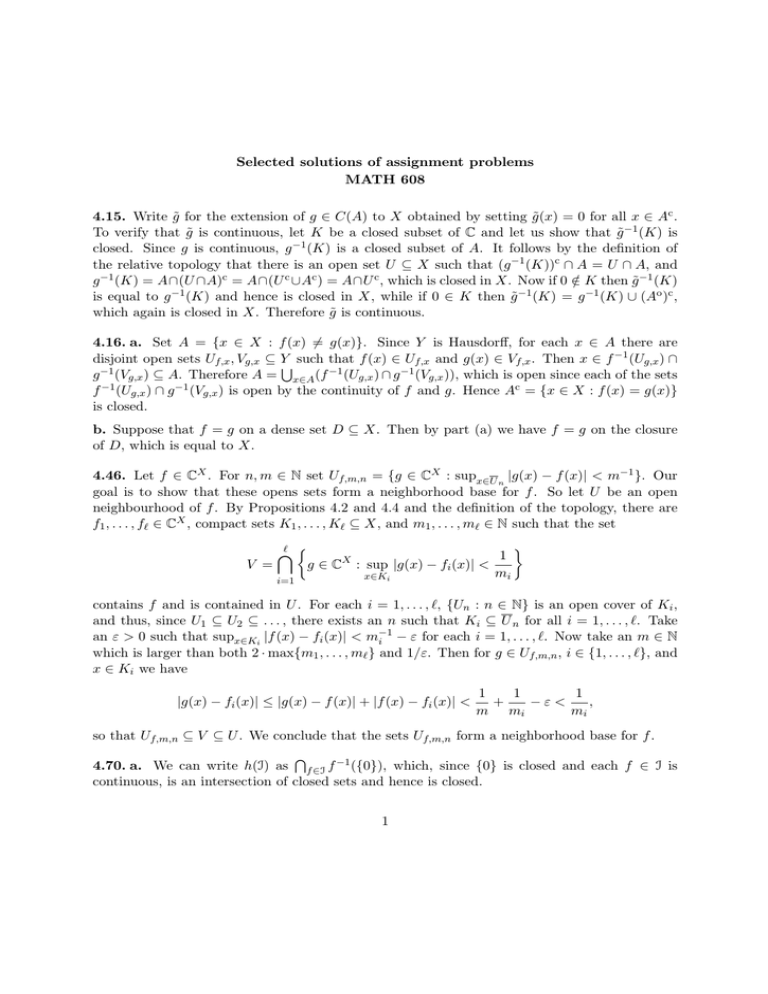
Selected solutions of assignment problems
MATH 608
4.15. Write g̃ for the extension of g ∈ C(A) to X obtained by setting g̃(x) = 0 for all x ∈ Ac .
To verify that g̃ is continuous, let K be a closed subset of C and let us show that g̃ −1 (K) is
closed. Since g is continuous, g −1 (K) is a closed subset of A. It follows by the definition of
the relative topology that there is an open set U ⊆ X such that (g −1 (K))c ∩ A = U ∩ A, and
g −1 (K) = A∩(U ∩A)c = A∩(U c ∪Ac ) = A∩U c , which is closed in X. Now if 0 ∈
/ K then g̃ −1 (K)
−1
−1
is equal to g (K) and hence is closed in X, while if 0 ∈ K then g̃ (K) = g −1 (K) ∪ (Ao )c ,
which again is closed in X. Therefore g̃ is continuous.
4.16. a. Set A = {x ∈ X : f (x) 6= g(x)}. Since Y is Hausdorff, for each x ∈ A there are
disjoint open sets Uf,x , Vg,x ⊆ Y
such that f (x) ∈ Uf,x and g(x) ∈ Vf,x . Then x ∈ f −1 (Ug,x ) ∩
S
g −1 (Vg,x ) ⊆ A. Therefore A = x∈A (f −1 (Ug,x ) ∩ g −1 (Vg,x )), which is open since each of the sets
f −1 (Ug,x ) ∩ g −1 (Vg,x ) is open by the continuity of f and g. Hence Ac = {x ∈ X : f (x) = g(x)}
is closed.
b. Suppose that f = g on a dense set D ⊆ X. Then by part (a) we have f = g on the closure
of D, which is equal to X.
4.46. Let f ∈ CX . For n, m ∈ N set Uf,m,n = {g ∈ CX : supx∈U n |g(x) − f (x)| < m−1 }. Our
goal is to show that these opens sets form a neighborhood base for f . So let U be an open
neighbourhood of f . By Propositions 4.2 and 4.4 and the definition of the topology, there are
f1 , . . . , f` ∈ CX , compact sets K1 , . . . , K` ⊆ X, and m1 , . . . , m` ∈ N such that the set
V =
` \
i=1
g∈C
X
1
: sup |g(x) − fi (x)| <
mi
x∈Ki
contains f and is contained in U . For each i = 1, . . . , `, {Un : n ∈ N} is an open cover of Ki ,
and thus, since U1 ⊆ U2 ⊆ . . . , there exists an n such that Ki ⊆ U n for all i = 1, . . . , `. Take
an ε > 0 such that supx∈Ki |f (x) − fi (x)| < m−1
i − ε for each i = 1, . . . , `. Now take an m ∈ N
which is larger than both 2 · max{m1 , . . . , m` } and 1/ε. Then for g ∈ Uf,m,n , i ∈ {1, . . . , `}, and
x ∈ Ki we have
|g(x) − fi (x)| ≤ |g(x) − f (x)| + |f (x) − fi (x)| <
1
1
1
+
−ε<
,
m mi
mi
so that Uf,m,n ⊆ V ⊆ U . We conclude that the sets Uf,m,n form a neighborhood base for f .
T
4.70. a. We can write h(I) as f ∈I f −1 ({0}), which, since {0} is closed and each f ∈ I is
continuous, is an intersection of closed sets and hence is closed.
1
b. The set k(E) is clearly a vector subspace, and if f ∈ k(E) and g ∈ C(X, R) then for x ∈ E we
have (f g)(x) = f (x)g(x) = 0·g(x) = 0 so that f g ∈ k(E), showing that k(E) is an ideal. Now if f
is a function in C(X, R) such that f (x) 6= 0 for some x ∈ E then {g ∈ C(X, R) : kg−f k < |f (x)|}
is a neighborhood of f which does not intersect E. Thus E c is open and hence E is closed.
c. Obviously E ⊆ h(k(E)). By part (a) the set h(k(E)) is closed, and so E ⊆ h(k(E)). Now let
x∈
/ E. By Urysohn’s lemma there is an f ∈ C(X, R) such that f |E = 0 and f (x) = 1. Then
f ∈ k(E), and so x ∈
/ h(k(E)). We conclude that h(k(E)) = E.
d. Obviously I ⊆ k(h(I). By part (b) the set k(h(I) is closed and hence I ⊆ k(h(I)). Observe
that I is a subalgebra of C0 (h(I)c , R), since for every f ∈ I and ε > 0 we can find, using
the continuity of f and the fact that h(I) is compact by part (a), a neighborhood V of h(I)
such that |f (x)| < ε for all x in the set V c , which is compact in X and hence also compact
in h(I)c . Now if x and y are distinct points in ∈ h(I)c then we can find an f ∈ I such that
f (x) 6= 0 and, by Urysohn’s lemma, an g ∈ C0 (h(I)c , R) such that g(x) = 1 and g(y) = 0, in
which case f g is an element of I whose values are different on x and y. We can thus apply
Proposition 4.36 to the one-point compactification of h(I)c and appeal to the Stone-Weierstrass
theorem to conclude that I = C0 (h(I)c , R). (One can also take an approach that avoids the
Stone-Weierstrass theorem in favor of the argument in the solution to 4.71(b) below.)
e. The map E 7→ k(E) from the closed subsets of X to the closed ideals of C(X, R) is injective
since h(k(E)) = E by part (c). It is surjective since given a closed ideal I in C(X, R) we have
k(h(I)) = I by part (d).
4.71. a. Set I = {f ∈ C(X, R) : ϕ(f ) = 0}. Suppose there is a proper linear subspace J of
C(X, R) which contains I as a proper subset. Take a g ∈ J \ I and an h ∈ C(X, R) \ J. Then
ϕ(g) 6= 0, and we can define g̃ = (ϕ(h)/ϕ(g))g, which is an element of J \ I since J and I are
subspaces. But then ϕ(h − g̃) = 0 so that h − g̃ ∈ I and hence h ∈ I + g̃ ⊆ J, a contradiction.
We conclude that I is a maximal proper ideal.
b. Suppose to the contrary that for every x ∈ X there is an fx ∈ I such that fx (x) 6= 0. Then
by continuity we can find for each x ∈ X an open neighborhood Ux of x S
such that |fx (x)| > 0
for all
Px ∈ Ux . By compactness there is a finite set F ⊆ X such that x∈F Ux = X. Then
g = x∈F fx2 is a function in I which is strictly positive and hence invertible. It follows that
1 = g −1 g ∈ I, and since every f ∈ C(X, R) can be written as f · 1 this implies that I = C(X, R),
a contradiction.
c. The map x 7→ x̂ from X to M is injective, for if x and y are distinct elements of X
then Urysohn’s lemma yields an f ∈ C(X, R) such that f (x) = 1 and f (y) = 0, whence
x̂(f ) = f (x) 6= f (y) = ŷ(f ). Now suppose we are given a ϕ ∈ M . Since ker ϕ is an ideal, by
part (b) there exists an x0 ∈ X such that f (x0 ) = 0 for all f ∈ ker ϕ. Then ker ϕ ⊆ ker x̂0 and
so ker ϕ = ker x̂0 since ker x̂0 is a proper ideal and, by part (a), ker ϕ is a maximal proper ideal.
It follows that x̂0 = ϕ, showing that the map x 7→ x̂ is surjective.
2
c. By Proposition 4.28, we need only show that the map x 7→ x̂ from X to M is continuous.
But if {xα }α is a net in X converging to some x ∈ X then for every f ∈ C(X) we have
x̂α (f ) = f (xα ) → f (x) = x̂(f ) by continuity.
4.71. In `2 (A), the coordinate vectors eα for α ∈ A given by eα (α0 ) = 1 if α0 = α and eα (α0 ) = 0
otherwise form a set which is evidently orthonormal and complete by the definition of `2 (A) and
hence is an orthonormal basis. We similarly have the coordinate vector basis {eβ }β∈B for `2 (B).
Thus if card(A) = card(B) we can take a bijection θ : A → B and define a bijective linear map
U : `2 (B) → `2 (A) by U ((xβ )β ) = (xθ(α) )α , which is isometric by Parseval’s identity and hence
is a unitary isomorphism.
Conversely, if we are given a unitary isomorphism U : `2 (B) → `2 (A) then the image of
{eβ }β∈B is an orthonormal basis for `2 (A) with cardinality card(B). Since {eα }α∈A is an
orthonormal basis for `2 (A) with cardinality card(B) and any two orthonormal bases of a
given Hilbert space have the same cardinality (we proved this for Hilbert spaces admitting
a countable orthonormal basis, but the same argument works in general), we conclude that
card(A) = card(B).
7.11. Let 0 < α < µ(A). To show the existence of a Borel set B ⊆ A with µ(B) = α we may
assume that A is compact by replacing it with a compact subset of measure greater than α using
inner regularity. Let C be the collection of all relatively open subsets B ⊆ A with µ(B) ≤ α,
directed by inclusion.SNote that every linearly ordered subcollection {Ui }i∈I of C has an upper
bound, namely U = ∞
i=1 Ui . Indeed U is a relatively open subset of A, and if it were the case
that µ(U ) > α then by inner regularity we could find a compact set K ⊆ U with µ(K) > α, and
the open cover {Ui }i∈I of K would admit a finite subcover, in which case the largest member of
this subcover would contain K and hence have measure great than α, a contradiction. Therefore
by Zorn’s lemma C has a maximal element U .
Suppose that µ(U ) < α. For every x ∈ A \ U there is, by outer regularity and the hypothesis
µ({x}) = 0, an open set Vx containing x such that µ(Vx ) < α−µ(U
P). Since A\U is compact, there
is a finite set F ⊆ A \ U such that {Vx }x∈F covers A \ U . Since x∈F µ(Vx \ U ) ≥ µ(A \ U ) > 0
there is a particular x ∈ F such that µ(Vx \ U ) > 0. Now µ(Vx ∪ U ) ≤ µ(Vx ) + µ(U ) < α so that
Vx ∪ U ∈ C, while µ(Vx ∪ U ) = µ(U ) + µ(Vx \ U ) > µ(U ) so that U is a proper subset of Vx ∪ U ,
contradicting maximality. We conclude that µ(U ) = α.
3
